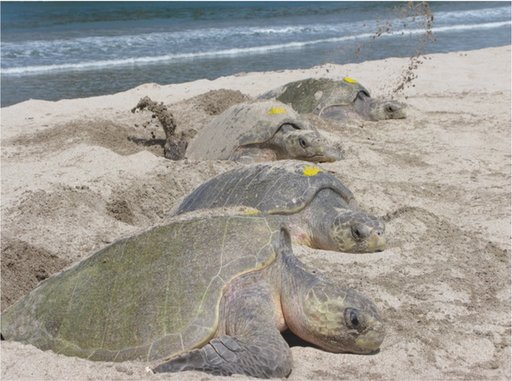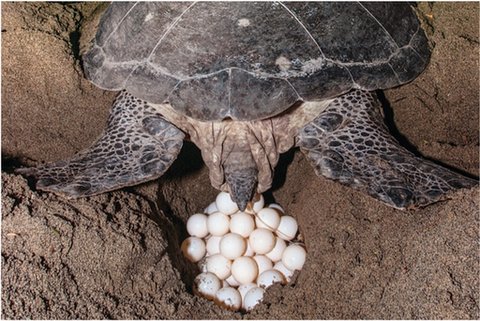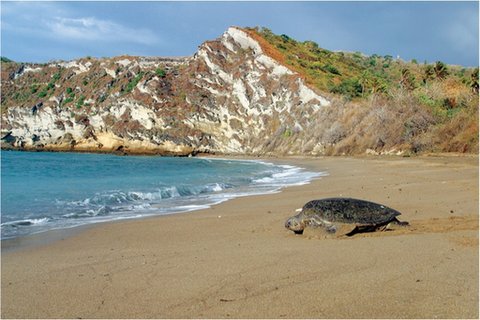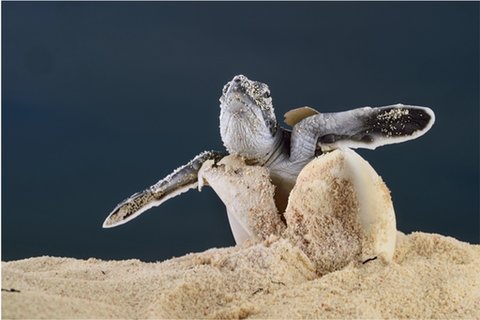Underthecoverofdarkness,athiefwaits.HiseyesscantheNicaraguanbeach.Beforelong,hespotswhatheislookingfor.Agreenseaturtleisdiggingalargenest.Shebeginstolayhereggsinthenest.Thethiefcomescloser.Themotherturtlefallsintoatrancewhileshelayshereggs.Shedoesnotnoticethe thief.
Thethiefreachesintothenestandbeginstopulltheeggsout,onebyone,andplacetheminawovenbasket.Theturtlemotherlaysherlasteggandusesherbackflipperstocoverthenest.Shethinkshereggsaresafe.Shedoesnotknowthatthenestisnowempty,andthethiefhastakeneverylasteggto sell.
CARIBBEAN
SEA
PACIFIC
OCEAN
HONDURAS
Nicaragua
Costa Rica
Chacocente
La Flor
Beaches where
seaturtles nest
ChacocenteandLaFlorareareasfamousfortheirseaturtles.Oliveridleyturtlescometothesebeachesbythethousandstolaytheireggsduringarribadas.Arribadameans“arrival”in Spanish.
Struggle
forSurvival
Seaturtleshavelivedinouroceansformillionsofyears.Butnowtheyareamongthemostendangeredspeciesonourplanet.Asfewasonein10,000babyseaturtleswillsurvivetoadulthood.Theyfacemanythreats.Aftertheyhatch,theymustcrawlfromtheirneststotheocean.Birdsandotheranimalstrytoeatthemfirst.Iftheyoungturtlesmakeittotheocean,theyfaceotherpredatorsinthewater.Somedieinfishingnets.Othersdiefromeatingplastic trash.
Today,allbutoneoftheworld’ssevenseaturtlespeciesareintrouble,accordingtotheIUCNRedList.Andtheonethat’snot—theflatbackseaturtle—islistedas “datadeficient.”Thatmeansscientistssimplydon’thaveenoughinformationtoknowhowitisdoing.OfthefourspeciesthatcometoNicaraguatolaytheireggs,leatherbacksandhawksbillsareclassifiedas“criticallyendangered.”Greenseaturtlesare“endangered.”Oliveridleyseaturtlesare “vulnerable.”

Greenseaturtlesareanendangered species.

Somefemaleoliveridleyseaturtlesnestin groups.
Ofallthedangersseaturtlesface,thegreatestthreatispeople.Peopleinsomecultureseatseaturtleeggs.AcrossCentralAmerica,poachers destroymorethan90 percentofseaturtlenestsonunguardedbeaches.Theeggsaresmuggledintocitieswheretheyareeatenin restaurants.
Itonlytakesonepoachertocausealotofdamage.Astretchofcoastlinemayhaveonlyafewfemaleturtles.Ifonepersonweretosystematicallyrobeverynest,thatpersoncouldsingle-handedlythreatenaspecies.Poachersmakebetween50centsandtwodollarsperdozeneggs.Butthedemandforseaturtleeggsissohigh,asingleeggcanbesoldforasmuchas $300.
Littleisknownabouttheroutespoachersuseorthefinaldestinationsforthesmuggledeggs.So,thepoachersarehardtocatch.Eatingtheeggsissoingrainedinsomeculturesthatevenwhencaught,thepoachersarerarelypunished.Givenallthesefactors,theriskstoturtleeggsseemedinsurmountable.Untilonescientisthadan idea.


1
Afemaleseaturtlecomesontoa beach.
2
Usingherflipperstodig,shecreatesashallow nest.


3
Themotherturtlelaysasmanyas120eggsinthe nest.
4
Shecoversthenestwithsandandreturnstothe sea.


5
Afterseveralweeks,thehatchlingsbreakthroughtheir shells.
6
Theyoungturtlesmaketheirwayacrossthebeachtoreachthe ocean.
